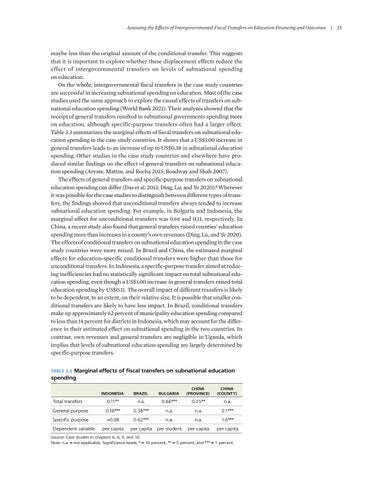Assessing the Effects of Intergovernmental Fiscal Transfers on Education Financing and Outcomes | 25
maybe less than the original amount of the conditional transfer. This suggests that it is important to explore whether these displacement effects reduce the effect of intergovernmental transfers on levels of subnational spending on education. On the whole, intergovernmental fiscal transfers in the case study countries are successful in increasing subnational spending on education. Most of the case studies used the same approach to explore the causal effects of transfers on subnational education spending (World Bank 2021). Their analyses showed that the receipt of general transfers resulted in subnational governments spending more on education, although specific-purpose transfers often had a larger effect. Table 3.3 summarizes the marginal effects of fiscal transfers on subnational education spending in the case study countries. It shows that a US$1.00 increase in general transfers leads to an increase of up to US$0.38 in subnational education spending. Other studies in the case study countries and elsewhere have produced similar findings on the effect of general transfers on subnational education spending (Arvate, Mattos, and Rocha 2015; Boadway and Shah 2007). The effects of general transfers and specific-purpose transfers on subnational education spending can differ (Das et al. 2013; Ding, Lu; and Ye 2020).4 Wherever it was possible for the case studies to distinguish between different types of transfers, the findings showed that unconditional transfers always tended to increase subnational education spending. For example, in Bulgaria and Indonesia, the marginal effect for unconditional transfers was 0.66 and 0.11, respectively. In China, a recent study also found that general transfers raised counties’ education spending more than increases in a county’s own revenues (Ding, Lu, and Ye 2020). The effects of conditional transfers on subnational education spending in the case study countries were more mixed. In Brazil and China, the estimated marginal effects for education-specific conditional transfers were higher than those for unconditional transfers. In Indonesia, a specific-purpose transfer aimed at reducing inefficiencies had no statistically significant impact on total subnational education spending, even though a US$1.00 increase in general transfers raised total education spending by US$0.11. The overall impact of different transfers is likely to be dependent, to an extent, on their relative size. It is possible that smaller conditional transfers are likely to have less impact. In Brazil, conditional transfers make up approximately 62 percent of municipality education spending compared to less than 14 percent for districts in Indonesia, which may account for the difference in their estimated effect on subnational spending in the two countries. In contrast, own revenues and general transfers are negligible in Uganda, which implies that levels of subnational education spending are largely determined by specific-purpose transfers. TABLE 3.3 Marginal effects of fiscal transfers on subnational education spending INDONESIA
BRAZIL
BULGARIA
CHINA (PROVINCE)
CHINA (COUNTY)
Total transfers
0.11**
n.a.
0.66***
0.25**
n.a.
General purpose
0.18***
0.38***
n.a.
n.a.
0.1***
Specific purpose
−0.08
0.62***
n.a.
n.a.
1.6***
per capita
per capita
per student
per capita
per capita
Dependent variable
Source: Case studies in chapters 6, 8, 9, and 10. Note: n.a. = not applicable. Significance levels: * = 10 percent, ** = 5 percent, and *** = 1 percent.






